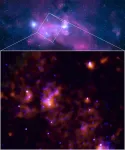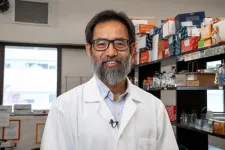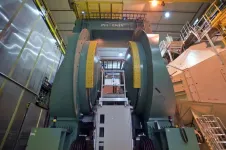(Press-News.org) In a new paper published today in Nature, researchers at the Francis Crick Institute have outlined the structure and function of a protein complex which is required to repair damaged DNA and protect against cancer.
Every time a cell replicates, mistakes can happen in the form of mutations, but specialised proteins exist to repair the damaged DNA.
People with mutations in a DNA repair protein called BRCA2 are predisposed to breast, ovarian and prostate cancers, which often develop at a young age. In the clinic, these cancers are treated with a drug that inhibits PARP, another protein needed for DNA repair.
Recent work shows that defects in several other proteins can cause inheritable breast and ovarian cancers or Fanconi anaemia, a blood disorder that can lead to different cancers, including leukaemia.
The researchers used cryo-electron microscopy to reveal the atomic structure of four of these proteins, which come together to form a complex called BCDX2. This allowed them to map mutations associated with cancer on the 3D structure, revealing the important regions of the complex, and why certain mutations prevent DNA repair, leading to an instability in a person’s genes and cancer.
In addition, the researchers discovered BCDX2’s role in the cell, finding that it acts as a ‘molecular chaperone’ – it helps target another protein called RAD51, causing it to recognise and assemble at regions where DNA repair needs to take place. Together, BRCA2, BCDX2 and RAD51 are the main players in the process that repairs damaged DNA – called ‘homologous recombination’.
The research shows that BCDX2 is just as important for repairing DNA as BRCA2, suggesting mutations should also be routinely screened for.
Luke Greenhough, co-first author and postdoctoral research assistant at the Crick, said: “For the first time, we’ve been able to show the direct links between structure, function and why mutations in any of the components of BCDX2 leads to cancer. We now understand its crucial role in DNA repair, which explains why mutations can lead to cancer.”
Eric Liang, co-first author and postdoctoral fellow at the Crick, said: “Just five years ago we wouldn’t have been able to do this - the rapid advance of technology has made this research possible. DeepMind’s AlphaFold2 (a computer programme which can predict a protein’s 3D structure), cryo-EM and high-resolution imaging techniques allowed us to gather the full picture of structure and function for this key protein complex. It was a very collaborative project, spanning multiple labs and technical teams across the Crick.”
The research today could help inform the best line of treatment for people living with cancer.
Steve West, group leader of the DNA Recombination and Repair Laboratory at the Crick, said: “BRCA2 is well characterised and known to increase the risk of cancer, especially breast and ovarian cancers. It’s mutated in 15-20% of inheritable cancer cases so is regularly screened for.
“Our research has shown that BCDX2 is also crucial for DNA repair and acts in the same pathway as BRCA2. For people with cancers caused by defects in BCDX2, PARP inhibitors are also likely to be effective. Our findings suggest that people with a family history of these cancers should be screened for mutations in the proteins making up BCDX2 to get a full picture of their risk.”
The researchers are now hoping to shed light on another protein complex, CX3, which is also involved in cancer. Putting all these insights together will allow a better understanding of genes which put people at a greater risk of cancer and help with targeted treatment.
-ENDS-
For further information, contact: press@crick.ac.uk or +44 (0)20 3796 5252
Notes to Editors
Reference: Greenhough, L. et al. (2023). Structure and mechanism of action of the RAD51BCD-XRCC2 tumour suppressor complex. Nature. 10.1038/s41586-023-06179-1.
The Francis Crick Institute is a biomedical discovery institute dedicated to understanding the fundamental biology underlying health and disease. Its work is helping to understand why disease develops and to translate discoveries into new ways to prevent, diagnose and treat illnesses such as cancer, heart disease, stroke, infections, and neurodegenerative diseases.
An independent organisation, its founding partners are the Medical Research Council (MRC), Cancer Research UK, Wellcome, UCL (University College London), Imperial College London and King’s College London.
The Crick was formed in 2015, and in 2016 it moved into a brand new state-of-the-art building in central London which brings together 1500 scientists and support staff working collaboratively across disciplines, making it the biggest biomedical research facility under a single roof in Europe.
http://crick.ac.uk/
END
The discovery of the quantum Hall effects in the 1980's revealed the existence of novel states of matter called "Laughlin states", in honor of the American Nobel prize winner who successfully characterized them theoretically. These exotic states specifically emerge in 2D materials, at very low temperature and in the presence of an extremely strong magnetic field. In a Laughlin state, electrons form a peculiar liquid, where each electron dances around its congeners while avoiding them as much as possible. Exciting such a quantum liquid generates collective states that physicists associate to fictitious particles, whose ...
New research is increasing our understanding about why some women with the most lethal form of ovarian cancer respond much better to treatment than others.
Researchers at Imperial College London have confirmed that the tumours of some women with high-grade serious ovarian cancer (HGSOC) contain a type of lymphoid tissue – known as tertiary lymphoid structures, or TLS – and that the presence of this tissue gives women a significantly better prognosis. They have also identified genes in HGSOC ...
An international team of scientists has discovered that Sagittarius A* (Sgr A*)1, the supermassive black hole at the centre of the Milky Way, emerged from a long period of dormancy some 200 years ago. The team, led by Frédéric Marin2, a CNRS researcher at the Astronomical Strasbourg Observatory (CNRS/University of Strasbourg), has revealed the past awakening of this gigantic object, which is four million times more massive than the Sun. Their work is published in Nature on 21 June. Over a period of one year at the beginning of the 19th century, the black ...
New Haven, Conn. — Cancer immunotherapy has revolutionized treatment of many forms of cancer by unleashing the immune system response against tumors. Immunotherapies that block checkpoint receptors like PD-1, proteins that limit the capacity of T cells to attack tumors, have become the choice for the treatment of numerous types of solid cancer.
However, the introduction of PD-1-blocking agents can often result in T cells attacking healthy tissues in addition to cancer cells, causing severe, sometimes life-threatening, side effects that can blunt the benefits of immunotherapy.
A new study published by researchers ...
New McMaster research has found that a disease-causing fungus — collected from one of the most remote regions in the world — is resistant to a common antifungal medicine used to treat infections.
The study, published today in mSphere, showed that seven per cent of Aspergillus fumigatus samples collected from the Three Parallel Rivers region in Yunnan, China were drug resistant.
Perched 6,000 metres above sea level and guarded by the staggering glaciated peaks of the Eastern Himalayas, the region is sparsely populated and undeveloped, which makes the presence of antimicrobial-resistant strains of A. fumigatus all the more striking for Jianping Xu, ...
UPTON, NY— A new publication by the PHENIX Collaboration at the Relativistic Heavy Ion Collider (RHIC) provides definitive evidence that gluon “spins” are aligned in the same direction as the spin of the proton they’re in. The result, just published in Physical Review Letters, provides theorists with new input for calculating how much gluons—the gluelike particles that hold quarks together within protons and neutrons—contribute to a proton’s ...
HOUSTON ― Researchers at The University of Texas MD Anderson Cancer Center have uncovered a gene on the Y chromosome that is upregulated in KRAS-mutated colorectal cancer (CRC), increasing tumor cell invasiveness and reducing anti-tumor immunity in male patients.
The preclinical study, published today in Nature, provides novel insights into the longstanding mystery of molecular and cellular mechanisms that drive increased metastasis and poor prognosis in men with CRC. The results highlight the Y chromosome gene KDM5D, which codes for an epigenetic enzyme, as a potential therapeutic target and uncover ...
‘Green’ farming policies may accelerate global biodiversity loss, two leading academics have warned.
Rewilding, organic farming and the ‘nature friendly farming’ measures included in some government conservation policies risk worsening the global biodiversity crisis by reducing how much food is produced in a region, driving up food imports and increasing environmental damage overseas.
In an article published today in the journal Nature, Professor Ian Bateman of the University of Exeter and Professor Andrew Balmford of the University of Cambridge urge policy-makers to consider a bolder approach known as ...
Digital Science, a technology company serving stakeholders across the research ecosystem, is pleased to announce that Stellenbosch University (SU) has selected Symplectic Elements from Digital Science’s flagship products to support its goal of advancing knowledge in service of society.
Symplectic Elements will provide SU with a Researcher Profiles and Research Outputs Management Solution, supporting and streamlining DHET (Department of Higher Education and Training) submissions and providing a public profiling system for its researchers.
SU is one of South Africa’s leading tertiary institutions, and is recognised internationally ...
Brazil has a housing deficit of 5.876 million units (5.044 million in urban areas and 832,000 in rural areas), according to the latest government survey. The number corresponds to 8.1% of the nation’s total stock of private dwellings, permanent and improvised. To make good at least part of this huge social debt, the federal government launched a low-income housing program called Minha Casa Minha Vida (“My Home My Life”) in 2009.
However, funding was insufficient to meet demand of this size, and low investment allocated to construction of each unit resulted in problems such as lack of thermal comfort, a constant ...






